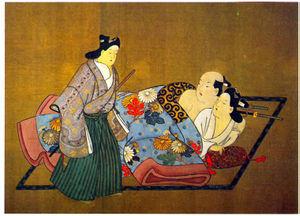
Miyagawa Choshun
Encyclopedia

was a Japanese painter in the ukiyo-e
Ukiyo-e
' is a genre of Japanese woodblock prints and paintings produced between the 17th and the 20th centuries, featuring motifs of landscapes, tales from history, the theatre, and pleasure quarters...
style. Founder of the Miyagawa school, he and his pupils are among the few ukiyo-e artists to have never created woodblock prints. He was born in Miyagawa, in Owari province
Owari Province
was an old province of Japan that is now the western half of present day Aichi Prefecture, including much of modern Nagoya. Its abbreviation is Bishū .-History:The province was created in 646....
, but lived much of his later life in Edo
Edo
, also romanized as Yedo or Yeddo, is the former name of the Japanese capital Tokyo, and was the seat of power for the Tokugawa shogunate which ruled Japan from 1603 to 1868...
, where he died. Unlike many ukiyo-e artists, Chōshun painted for most of his life.
Chōshun trained under artists of the Tosa
Tosa school
The Tosa school of Japanese painting was founded in the 15th century, and was devoted to yamato-e, which are paintings specializing in subject matter and techniques derived from ancient Japanese art, as opposed to schools influenced by Chinese art....
and Kanō school
Kano school
The ' is one of the most famous schools of Japanese painting. The Kanō school of painting was the dominant style of painting until the Meiji period.It was founded by Kanō Masanobu , a contemporary of Sesshū and student of Shūbun...
s, as well as under the master of early ukiyo-e, Hishikawa Moronobu
Hishikawa Moronobu
was a Japanese painter and printmaker known for his advancement of the ukiyo-e woodcut style starting in the 1670s.-Early life and training:Moronobu was the son of a well-respected dyer and a gold and silver-thread embroiderer in the village of Hodamura, Awa Province, near Edo Bay. After moving to...
. These influences are evident in his works, along with those of the Kaigetsudō school
Kaigetsudo school
The Kaigetsudō school was a school of ukiyo-e painting and printmaking founded in Edo around 1700-1714. It is often said that the various Kaigetsudō artists' styles are so similar, many scholars find it nearly impossible to differentiate them; thus, many Kaigetsudō paintings are attributed to the...
, but ultimately Chōshun, as the founder of a new school of painting, has a unique style all his own. His figures have a soft, warm femininity about them, and his coloring is among the best in all of ukiyo-e art. His works are almost exclusively of courtesans, and in his works these figures are fuller, and more voluptuous than those of many other artists, in particular those of the somewhat later artist Harunobu
Suzuki Harunobu
was a Japanese woodblock print artist, one of the most famous in the Ukiyo-e style. He was an innovator, the first to produce full-color prints in 1765, rendering obsolete the former modes of two- and three-color prints. Harunobu used many special techniques, and depicted a wide variety of...
. Though many of his pieces are clean ones of courtesans, Chōshun and his students also produced a great number of works of shunga
Shunga
' is a Japanese term for erotic art. Most shunga are a type of ukiyo-e, usually executed in woodblock print format. While rare, there are extant erotic painted handscrolls which predate the Ukiyo-e movement...
(erotic paintings).
Miyagawa Chōshun had a number of pupils, including his son Shunsui
Miyagawa Shunsui
"Shunsui" redirects here. For the 19th c. doban artist, see Yomo Shunsui; for the writer, see Tamenaga Shunsui; for the anime character, see Shunsui Kyōraku....
, Chōki (who may have also been his son), and Isshō
Miyagawa Issho
Miyagawa Isshō was a Japanese painter in the ukiyo-e style, primarily depicting kabuki actors, geisha, sumo wrestlers, and other elements of everyday urban culture. He was a pupil of Miyagawa Chōshun , who, in turn, was influenced by the works of Hishikawa Moronobu...
.
In 1751, a few years before his death, Chōshun was commissioned by an artist of the Kanō school to perform some restoration work at the Nikkō Tōshō-gū
Nikko Tosho-gu
is a Shinto shrine located in Nikkō, Tochigi Prefecture, Japan. It is part of the "Shrines and Temples of Nikkō", a UNESCO World Heritage Site.Tōshō-gū is dedicated to Tokugawa Ieyasu, the founder of the Tokugawa shogunate. Initially built in 1617, during the Edo period, while Ieyasu's son Hidetada...
. When Chōshun was not paid for his work, an altercation erupted which ended in the death of the Kanō artist at the hands of Chōshun's son. As a result, Chōshun was banished from Edo for a year.

